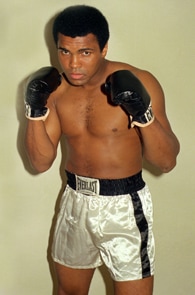Boxing Training is Not Just A Hard Workout – It’s Fun

Looking for a creative way to add some fun to your workout? Consider boxing training. Boxers are universally known as the hardest working, leanest, and most well conditioned athletes on the planet. That’s because facing an opponent in the ring for 12 rounds and dodging and delivering punches is extremely physically taxing. And boxing training prepares them for that.
But boxing training isn’t just for aspiring boxers. The average health and fitness enthusiast can use basic boxing training techniques to add fun, creativity, and intensity into their workout routine.
We’ll discuss the easiest ways to get started. These techniques can be scaled to any experience level.
Basics of Boxing Training
Boxing requires skill, endurance, and strength. In this series of articles, we’re going to focus on the methods used to train basic skill and endurance. We’re not going to cover techniques that require multiple people (such as the punch mitts or pads) or methods that differ little from standard endurance training, such as roadwork (running).
The techniques we’ll cover include:
- Shadowboxing – and the boxing stance, and punches
- Skipping Rope
- Speed Bag
- Heavy Bag
Timekeeping during training

All boxing training is done in the cadence of an actual fight – and that means 2 or 3 minute rounds, followed by 1 minute of rest.
The FitAtMidlife free workout timer is a great choice for boxing workouts. Simply set the round length setting to the desired time frame (typically 3 minutes) and the rest length to 1 minute, then click Start.
This timer is free, and works on Windows, Mac, iPhone, or Android.
Shadowboxing and the Boxing Stance
Shadowboxing is a staple of all boxing training. What’s shadowboxing? It’s sparring with an imaginary opponent. This is the training technique by which a fighter hones their basic skills – backwards and forwards movement, lateral (side to side) movement, and keeping the hands up and chin down (to prevent a knockout punch from landing). But throwing the boxing punches is also part of the experience: the jab, cross, uppercut, and hook.
Shadowboxing is all about repetition – practice makes perfect, and this technique allows a fighter to hone not just the individual movements, but to weave it all together into a fluid and fast motion.
But you can’t shadowbox proper (or throw punches) until you understand the boxing stance. So we’ll tackle that first.
Boxing Stance
What’s the boxing stance? It’s how the fighter stands in the ring to face their opponent. The stance used allows a fighter to optimize their movement, speed, and strength. You don’t want to be caught “flat-footed” by an incoming punch – it will knock you off balance. That’s from a defense perspective. From an offense perspective we want our feet planted well so we can deliver a devastating blow. And lastly being able to move around the ring is vital, so being able to move back and forth and side to side can make or break a fighter.
Knowing those are the goals of a good boxing stance, let’s discuss how to get into the proper stance. First of all, what’s your dominant side (your strong side)? If it’s your right, you’ll use what’s known as orthodox stance. For a leftie, you’ll use southpaw stance. We’re going to put the strong hand to the back – so we can potentially deliver a knockout blow with extreme power. We’re going to describe orthodox stance – because that’s what most people use – but southpaw is simply the mirror image of orthodox.
Foot positioning comes first. Place your left foot out in front, and your right foot back. Your feet should be about shoulder width apart. Your right foot should be pointed out at about a 30 degree angle. Flex your knees a bit to crouch down, dropping your height about 1-2 inches. Lastly, bring your rear heel up a bit, you will balance on the ball of the foot. The combination of these things gives us the ability to move back and forth, or left and right fluidly and with ease. Take a look at this photo of two Olympic boxers – note the foot positioning.

Next comes the hands and upper body – hold your hands up at about chin height. Your left hand will be out in front, and your right hand will be towards the back. When you deliver a right cross you’re going to be able to swivel your hips and put the entire weight of your body behind the blow (remember to keep the rear heel up). Keep your elbows tucked in – protect those ribs.

Now that you are in the stance – move forward by taking a small step with your left, then your right. Move backward. Move to the left or right by initiating the move from your back foot. Swivel such that you are continually facing your imaginary opponent. At this point it’s good to have a look in the mirror. Take a look – you’ve minimized the area your opponent can punch you. Your body is turned slightly sideways and you’ve given your enemy much less target area to punch.
Before you attempt the punches – do a few 3 minute rounds of pure, fluid movement. Back and forth, left and right, always pivoting to keep facing your imaginary opponent. You should also incorporate head movement – remember that in the ring the quickest route to a knockout is a blow to the chin or temple – so keep your head in constant motion. Imagine that you are dodging or slipping punches.
The Punches
In boxing, there are four basic punches:
- Jab – Flick your forward hand (left for orthodox, right for southpaw) forward. The goal of the jab isn’t power – it’s to annoy and put your opponent on the defense. You use it to lure them into position for a power shot. For the jab, concentrate on speed. Hand out , and back, quickly – otherwise you’d get punched in the ribs.
- Cross – The cross, or right cross for orthodox stance, is a power punch. Bring that right hand forward and twist your hips – pivoting on that rear foot. You can really deliver a lot of power with the cross. But the hand has got further to travel – remember it’s coming from further back – so it’s slower than the jab. Notice when you watch a boxing match, the majority of punches are jabs – setting up the power shots.
- Hook – Bring your lead (forward) hand out to the side and deliver this power punch perpendicular to your opponent. The hook should “hook around” from the side. It’s the punch they won’t see coming. It can also be thrown from the rear hand – but your opponent will see this coming from a mile away – so be careful with it. In either case, you’ve got to twist in the hips – that’s where hook power comes from – not the arms.
- Uppercut – When your opponent is in close, and his chin is exposed you bring a hand up quickly and crisply – aiming directly for the chin – or the solar plexus.
Once you’ve got a feel for the punches – put them together into combinations. Jab, Jab, Cross. Jab, Jab, Uppercut. Jab, Jab, Uppercut, Cross. Any boxer worth their salt can duck and dodge single punches all day long. The combinations are where you put a strategy together – throw them off balance with the jab, get them to raise their chin to avoid an uppercut, then hit them square in the chin with a right cross. That’s the essence of offense in boxing.
You don’t strictly need gloves or hand wraps for shadowboxing – remember you are not actually going to punch anything yet. But you will need boxing gloves if you intend to hit the heavy bag. Additionally, having gloves on while shadowboxing adds intensity and will help build endurance in the shoulders.
For shadowboxing, bag work, or even sparring – we recommend these Ringside Apex IMF boxing gloves (Buy on Amazon). They are available in 14oz and 16oz size and are a quality product – they incorporate injection molded foam to protect your hands when doing bag work. These are legitimate training gloves, made for real use and not the poor quality items found in your local sporting goods store.
Tie it all together into a workout
Try three or four 3 minute rounds of shadowboxing. Start the timer, and work hard and fast for the full 3 minutes. Rest for 1 minute, then repeat. Once you’ve done this a few times, you’ll appreciate the ferocious intensity of boxing training. Now just imagine if a live opponent was in the ring with you!
In our next installment, we’ll discuss another staple of boxing training – rope skipping. Check back soon for updates on that.
Photo credits
Olympic boxers photo credit: aiba.boxing American Olympic Qualifier Event – Buenos Aires 2016 via photopin (license)

Tim is the founder of FitAtMidlife.com – an avid gym rat for 30+ years, he’s a reviewer of many, many shoes – and founder of the Speed Bag Gathering – the world’s only gathering of speed bag punching enthusiasts. See more gym reviews at Tim’s YouTube channel.


